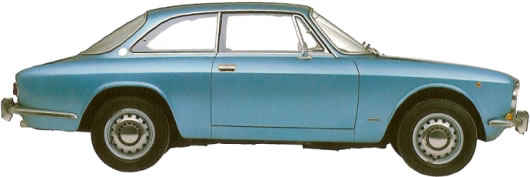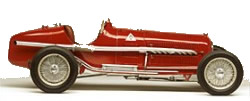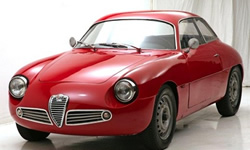 Alfa Romeo Automobiles S.p.A. is an Italian automaker founded on 24 June 1910 in Milan. Alfa Romeo has been a part of the Fiat Group since 1986. The company was originally known as A.L.F.A., which is an acronym for Anonima Lombarda Fabbrica Automobili (translated: Lombard Automobile Factory, Public Company).
Alfa Romeo Automobiles S.p.A. is an Italian automaker founded on 24 June 1910 in Milan. Alfa Romeo has been a part of the Fiat Group since 1986. The company was originally known as A.L.F.A., which is an acronym for Anonima Lombarda Fabbrica Automobili (translated: Lombard Automobile Factory, Public Company).
1900's: The Early Years
Surprisely the history of Alfa Romeo starts in France. Carmanufacturer Alexandre Darracq putted up a factory in Portello near by Milan. In this factory cars with one or two cylinder engines were build from parts imported from Paris. This project was not that succesfull as Alexandre Darracq hoped for and in 1909 he sold his factory to the Italian Anonima Lombarda Fabbrica Automobili, shortly A.L.F.A.
1910
And here the history begins:
In 1915 Nicola Romeo, a very skilfull engineer and keen on autosport became the head of this fabbrica and the name of this firm became Alfa Romeo. The early four-cylinder engines were replaced by six- and eight-cylinder engines from Merosi and Jano. Later on engines with double overhead camshafts and a compressor were used. Examples are the 3-litre 8-cylinder Tipo B, the Bimotore with two 8-cylinder engines and a 4.5-litre V12.
1930
1940
In 1947 already the 2.5 litre Freccia d’Oro (Golden Arrow) made its appearance. This car was a coupe with 5 seats and column mounted gearchange. In 1950 introduced Alfa her first 4-cylinder engine within 25 years: the 1900 Berlina
1950
Coupé-versions called Super and Sprint followed soon, just as racing-version called Disco Volante (Flying Saucer) in 1952. This car with a subversive designed body by Touring in Milan did not reach production, but a more conventional race-version of the Disco Volante with a 3.0litre 6-cylinder-engine captured a second place in the Mille Miglia from 1953 and won the Grand Prix from Merano.
In 1954 Alfa Romeo introduced the Giulietta, a concept reachable for the big public. This car had a 1300cc 4-cylinder-engine with double overhead camshafts and perfectly combined performance with low costs! It was delivered as coupé with two doors or saloon with four doors. Later on versions followed tuned by Pininfarina, Zagato and Bertone.
In the period 1950 till 1955 the Italian carproduction grew very fast and of course the Giulietta joined responsibility. This car and its versions were responsible for the growth Alfa Romeo knew for 8 years! In 1962 a bigger Giulia was presented. This car was equipped with a 1570cc engine, a five-speed gearbox and disc brakes on all wheels. The 1900 Super was build till 1956 and replaced by the bigger and more luxurious 2000 in 1958 which in 1962 appeared with a 2.6litre engine. All these types were deliverable with different kind of bodies and engines and they became very popular because of their outstanding performance and handling.
1960
The following year the build of a new factory was started in Arese near by Milan. This new factory replaced the one in Portello which had become too small. In the new factory the Tipo 33 racesportscar was developed. This Tipo 33 had a 2.0litre midplaced V-8 engine with DOHC. In 1971 the 3.0litre version of the 33 won the Targa Florio, the 1000km-race of Brands Hatch and the 6-hours race of Watkins Glen. And although the 33 was not without problems this car was the concept of perfect racesportcars as real Alfa Romeo traditions propagate! At the international carexhibition of Montreal in 1967 the Montreal designed by Bertone made its first appearance. It made use of a 2.6litre V-8 engine developed from the 2.0litre version, with fuelinjection and a five-speed gearbox. This very beautifull 2+2-seater was a very fast sportscar with real racequalities. A topspeed of 220km/h was given! The Montreal was build on the same chassis as the Giulia 1600 coupé and had the same stiff rear axle and its disc brakes on all wheels. This car got a outstanding reputation and became the pride of Alfa Romeo. In the period 1970 till 1975 3925 Montreals were build. In 1966 on the Salon the Genève Alfa Romeo introduced the 1600 Spider Duetto. This concept should be deliverable for almost 25 years! |
|
In 1968 also the Giulia with an 1779cc engine made its appearance and at the same time the Italian government had persuaded Alfa Romeo to build a new factory near by Naples on behalf of employment in the poor south. This new factory was opened in 1971 at the same time with the presentation of the Alfasud (Alfa South). This totally new developed car had a 1186cc boxerengine with SOHC, a four-speed gearbox, frontwheeldrive and McPherson frontsuspension. The design of Hruschka an Giugiaro was highly praised because of the outstanding road-handling, thanks to wide track of the car and the great balanced rearaxle. Disc brakes on 4 wheels and a 63bph engine encouraged to a lively and sportive way of driving. Marketing technical speeking the Alfasud was a winner and with faster versions Alfa Romeo took care that this car was a unbeatable offer in the sportive and compact marketsection. Giulietta (1961) |
1970
In 1971 the 1750cc engine was upgraded to 1962cc and one year later the name Alfetta was reborn. Now it was used for a saloon with a 1779cc 4-cylinder engine, a De Dion-rearaxle and a next to the diff placed 5-speed gearbox, just like the Grand Prix-car of 1951. Because of the concept engine frontside and the remaining components like gearbox and so on placed at the rearaxle the Alfetta had a very balanced and sportive handling when driving! Later on versions with the economical 1.6litre Giulia engine and 1.6, 1.8 and 2.0litre G.T.’s were added to the deliveryprogram.
1980
In 1981 the Alfasud got a fifth door. In 1984 the Sud was replaced by the Alfa Romeo 33. This car also got boxerengines with 1351cc, 1490cc or 1712cc and was continuing a great succes. In 1984 (but I can be wrong) Alfa introduced the Alfa 90 which replaced the Alfa 6. For this great car can be chosen from a 2.0litre 4-cylinder, a 2.0litre V-6, a 2.5litre V-6 or a 2.0litre VM-dieselengine. In 1986 after more than 20 years the name ‘Giulietta’ disappeared with the arrival of the Alfa Romeo 75, called Milano in the USA. The name 75 was given because of the 75 year jubilee of Alfa Romeo. The chassis with the rearplaced gearbox and the De Dion rearaxle was kept and the 75 could be equipped with engines from 1779cc till 2959cc with an 190bph. From 1988 on a 1570cc engine is also delivered for the Alfa 75. |
In 1987 Alfa Romeo is incorporated by the Fiatgroup and will represent the sportive part in the concern, where Lancia stands for luxurious cars and Fiat for the mainstream cars. In 1988 Alfa Romeo introduced the 164 with frontwheeldrive as the topmodel. Also is re-introduced the twinspark-system on the 1962cc engine (for the 164 and 75). This double ignition was already used in 1923 by Alfa and later on the GTA and the GTAm had such a system. In 1990 the 164 Quadrifolglio was presented to the world with a 200bph 3.0litre V-6 engine and in 1994 this engine got a 24valve-head so the engine could give a maximum output of 230bph! In 1989 during the Salon Genève Alfa Romeo amazed the world with the presentation of the SZ (Sport Zagato), also called ‘The Beast’. There should only be build a 1000 of this brutal car. The SZ was based on the 75 and had a 3.0litre tuned V-6 engine. In 1994 the RZ, a cabriolet based on the SZ is introduced. |
1990
In 1992 the Alfa Romeo 155 replaced the 75. The 155 has frontwheeldrive so at this moment only the Spider, designed by Pininfarina in 1966 has rearwheeldrive untill she will be replaced by a new Spider in 1993.
After a long time a new GTV is born in 1994, shown at Salon de Paris. The open version of this GTV is called Spider and replaces the former Spider.
In 1997 the 155 was replaced by the 156, a beautifull design from Alfa’s own Centro Stile (Walter de Silva) with retro styling characteristics. It became car of the year 1998 (of course!). End of 1999 a sportswagon of the Alfa 156 will be ready for production and here another tradition will be picked up where the production of the 33 Sportswagon was stopped.
In 1998 is Alfa back in the upperclass of cars with the 166, also developed in Alfa’s Centro Stile by Walter de Silva. This car is the succesor of the 164 which production already was stopped in 1997. The 166 is a beautifull, slim lined and sportive limousine with great highpowered straight-four and V-6's engines.
2000
In 2000 Alfa Romeo amazed the world again with introducing the 156 Sportswagon, a very beautifull and very handy car. Here Alfa Romeo picks up a short history of creating sportwagons, like the 33 in the eighties. Coming a 3 years later than the original 156 this car should do it very well in the lease-concept which should be leased by 156-owners and new-comers ending their one lease contract and starting an other.
In novembre 2000 the 147 was introduced. The 147 is the successor of the 145 / 146-range. With this car Alfa Romeo will start in the upper-middle class, starting with prices in the Netherlands from 42.000 guilders on. More about the 147 in 'The history of the Alfa Romeo 145'.
Alfa Romeo news: There are plans to develop an off-road. An prototype is already there. If this car reaches production it will be sold somewhere the year 2001. Also news is (and almost not survivable!) that Alfa, part of the Fiat-group maybe will work together with GM in the future, aarrgghhh, why should Fiat share knowledge, parts and money with a company like this? Good news is that there are rumours again about re-introducing rear wheel drive! Nothing sure, but hopefully true!
Alfa Romeo

The Sprint Coupe, debuted in 1963 as part of the Giulia family of cars which included saloons and Spiders designed by Giorgetto Giugiaro, was distinctive and handsome. The GTV (GT Veloce) was the fast version of the Sprint and shared the same mechanicals as other models in the range. Independent front suspension using double wishbones and an anti-roll bar, together with a live axle with trailing arms and anti-roll bar, made for fantastic handling with just a slight hint of understeer.
Surprisely the history of Alfa Romeo starts in France. Carmanufacturer Alexandre Darracq putted up a factory in Portello near by Milan. In this factory cars with one or two cylinder engines were build from parts imported from Paris. This project was not that succesfull as Alexandre Darracq hoped for and in 1909 he sold his factory to the Italian Anonima Lombarda Fabbrica Automobili, shortly A.L.F.A.







